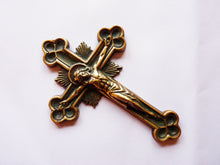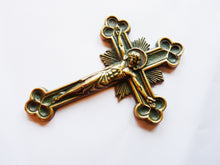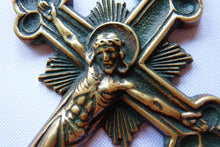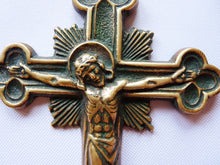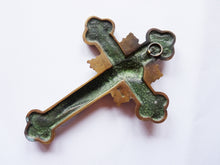
Bronze Wall Cross In The Style of Max Le Verrier, French Circa 1930, 19x14.5 Centimetres, Excellent Condition
First let me tell you about this lovely cross and then about the artist. It has a beautiful patina of age which you can see better on the photo of the reverse. The front is still a little bright in places, not from polishing, just from loving touches over many decades.
The four points of the cross represent the four evangelists who correspond to the main events of the life of Christ (birth, death, resurrection, ascension), which in turn symbolize: Matthew is the man, Luke the calf, Mark the lion, John the eagle.
At the top is the eagle, to the lft is the lion, to the right is the lamb and at the foot is the man.
As there is no signature I cannot confirm that this beautiful cross is by Max Le Verrier but I still would like to tell you his story.
Max Le Verrier was a remarkable man. He was born in Neuilly sur Seine on January 29, 1891.
His mother was Belgian and his father was a Parisian goldsmith and jeweler on Boulevard Malesherbes in Paris. His parents divorced when he was 7 years old.
He attended several boarding schools and was a brilliant student. His interest in drawing and sculpture occurred early, and he practiced his craft on wooden rulers, which he turned into little houses, churches, and other small items. However, his father decided he should go into farming, much against Max's wishes and when he was 16 he ran off to Paris at which point his father cut him off and so he had to fend for himself.
In 1909 at 18 he left for England where he met a Frenchman called Jameson who had bought a plane on credit and together they started a flying school. This was in the very early days of avaiation so it was difficult and Jameson sold his share to a wealthy Englishman. Max stayed on and repaired and improved the aircraft. In his pare time he taught himslf to fly and gained his pilot's licence in 1913.
Max returned to France at the outbreak of war and was assigned to an artillery unit but he wanted to fly and eventuall was transferred to a bomber unit. In May of 1915 he was shot down by two German fighters. He was pothumously awarded the military medal and the Croix de Guerre, but Max was not dead!
He had landed behind enemy lines and was taken to Munster in Germany where he remained for 3 years. As he was a pilot and non-commissioned officer, he was not required to work so he asked for tools and modelling clay and began sculpting seriously. He was transferred to an internment camp in Switzerland and managed to get to attend the school of fine arts in Geneva.
He returned to France after the armistice in 1918 with nothing.
At the Paris exhibition of 1925 which coined the term 'art deco' Max won the gold medal for sculpture.
What an amazing life





